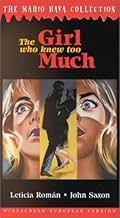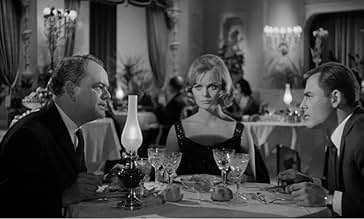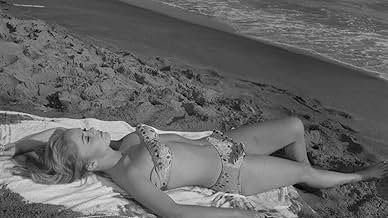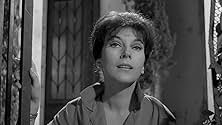AVALIAÇÃO DA IMDb
6,9/10
5,7 mil
SUA AVALIAÇÃO
Uma turista americana que adora romances misteriosos testemunha um assassinato em Roma, e logo sua vida mudará quando ela e seu pretendente estão envolvidos em uma série de assassinatos.Uma turista americana que adora romances misteriosos testemunha um assassinato em Roma, e logo sua vida mudará quando ela e seu pretendente estão envolvidos em uma série de assassinatos.Uma turista americana que adora romances misteriosos testemunha um assassinato em Roma, e logo sua vida mudará quando ela e seu pretendente estão envolvidos em uma série de assassinatos.
- Prêmios
- 1 vitória e 1 indicação no total
Letícia Román
- Nora Davis
- (as Leticia Roman)
- …
Walter Williams
- Dr. Alessi
- (as Robert Buchanan)
Giovanni Di Benedetto
- Professor Torrani
- (as Gianni De Benedetto)
Franco Moruzzi
- Policeman
- (as Franco Morici)
Dante DiPaolo
- Andrea Landini
- (as Dante Di Paolo)
Mario Bava
- Uncle Augusto
- (não creditado)
Geoffrey Copleston
- Asylum employee
- (não creditado)
Adriana Facchetti
- Woman in Sguattera Restaurant
- (não creditado)
Enredo
Você sabia?
- CuriosidadesMario Bava was a big fan of Alfred Hitchcock, and Hitchcockian touches abound in the film, including a cameo by the director. In the scene where Letícia Román is in her bedroom at Ethel's home, the portrait on the wall with the eyes that keep following her is that of Mario Bava.
- Erros de gravaçãoWhen Nora answers the phone in the Torrani house, "hello" is heard before she speaks, even while the receiver is being lifted to her mouth.
- Citações
Nora Davis: [into the phone] Oh mother, murders don't just happen like that here.
- Versões alternativasAIP released this as The Evil Eye, a recut version with material used just in some countries out of Italy.
- ConexõesFeatured in Mario Bava: Maestro of the Macabre (2000)
- Trilhas sonorasFurore
(Appears in the Italian version)
Sung by Adriano Celentano
Written and Composed by Adriano Celentano (as Adicel) and Paolo Vivarelli (as Vivarelli)
Published by Edizioni Nazionalmusic and Disco Jolly
Avaliação em destaque
This Bava film (whose title is clearly a nod to Alfred Hitchcock), credited with being the first giallo, was also one I could have watched earlier – having long considered picking up the now-OOP Image DVD, not to mention via a DivX copy I've owned for some time – but thought it best to wait for this definitive edition (complete with a Tim Lucas Audio Commentary).
Anyway, I don't know whether it's because I preceded it with Riccardo Freda's delirious and luridly-colored THE GHOST (1963) or the fact that the film retains an incongruous light touch (and leisurely pace) throughout – including the heroine's ruse to ensnare her stalker by the unlikely methods adopted in the pulp thrillers she avidly reads – but, while I enjoyed it a good deal, it felt to me like an altogether minor work from the maestro! Similarly, the murder sequences – a stylized highlight of later giallos – are pretty mild here. Still, Bava's consistent virtues – as a director – for creating tremendous suspense and the fantastic lighting and crisp cinematography that come with his intimate knowledge of the camera are well in evidence.
The first half-hour is pretty busy plot-wise, as all sorts of things happen to the charming leading lady (the striking-looking Leticia Roman, daughter of Oscar-winning costume designer Vittorio Nino Novarese): first she gets involved with a drug-dealer, then the old woman she was to live with dies on her, after which she roams outside in a frenzied state to be held up by a small-time crook and witness a knife-murder across Rome's famous Piazza di Spagna! Her disoriented frame-of-mind is effectively rendered by Bava through simple expedients, such as distorting lenses and focus-pulling. Incidentally, the foreigner-investigating-a-series-of-murders-in-Italy plot line prefigures such notable Dario Argento films as THE BIRD WITH THE CRYSTAL PLUMAGE (1970) and DEEP RED (1975). Interestingly, since there was no yardstick for the genre as yet, Bava relied on such familiar film noir trappings as first-person narration to push the story forward.
The film also features a young John Saxon in his first of many "Euro-Cult" outings as Roman's boyfriend and Valentina Cortese as her wealthy, eccentric landlady; the script provides plenty of suspects, but the final revelation comes as a surprise (though, in hindsight, it seems pretty obvious) – and this is followed by a lengthy explanation of the motive behind the killings, which became a standard 'curtain' for this type of thriller. There's an amusing final gag involving a packet of cigarettes and a priest, while Adriano Celentano's catchy pop song "Furore" serves as a motif during the course of the film.
Additional footage was prepared for the U.S. version (snippets of which are present in the accompanying trailer), while the title was changed to THE EVIL EYE and Roberto Nicolosi's score replaced with that of Les Baxter (as had already proved to be the case with Bava's BLACK Sunday [1960])! It would have been nice to have had this cut of the film (which is said to stress the comedy even more) included for the sake of comparison – and it had actually been part of the original announcement for "The Mario Bava Collection Vol. 1", along with the similar AIP variants for BLACK Sunday itself and BLACK SABBATH (1963), but these were subsequently retracted! Incidentally, I now regret not renting the alternate version of THE GIRL WHO KNEW TOO MUCH on DVD-R while I was in Hollywood – but, back then, I wanted first to watch the film as the director intended.
In John Saxon's otherwise entertaining interview on the Anchor Bay DVD (in which he recounts his experience working on this film and other stuff he made during his tenure in Italy), he erroneously mentions that he worked with director Lucio Fulci – whose name he even mispronounces as Luciano! Despite there being a considerable amount of dead air throughout Tim Lucas' Audio Commentary, it does a wonderful job at detailing the film's background – plus offering his own take on events: it does prove enlightening on several aspects of the film I had initially overlooked, such as how the costumes were carefully chosen to define character or the impressive contribution given by Dante di Paolo (George Clooney's uncle!) as the dour journalist investigating the murder spree. Surprisingly, Lucas also mentions that some of Bava's camera moves are more elaborate and graceful as seen in THE EVIL EYE (which makes me want to see it even more!) – but, then, important dialogue stretches heard in the Italian original involving the creepily asexual voice of the killer were bafflingly left out of the American version!!
Anyway, I don't know whether it's because I preceded it with Riccardo Freda's delirious and luridly-colored THE GHOST (1963) or the fact that the film retains an incongruous light touch (and leisurely pace) throughout – including the heroine's ruse to ensnare her stalker by the unlikely methods adopted in the pulp thrillers she avidly reads – but, while I enjoyed it a good deal, it felt to me like an altogether minor work from the maestro! Similarly, the murder sequences – a stylized highlight of later giallos – are pretty mild here. Still, Bava's consistent virtues – as a director – for creating tremendous suspense and the fantastic lighting and crisp cinematography that come with his intimate knowledge of the camera are well in evidence.
The first half-hour is pretty busy plot-wise, as all sorts of things happen to the charming leading lady (the striking-looking Leticia Roman, daughter of Oscar-winning costume designer Vittorio Nino Novarese): first she gets involved with a drug-dealer, then the old woman she was to live with dies on her, after which she roams outside in a frenzied state to be held up by a small-time crook and witness a knife-murder across Rome's famous Piazza di Spagna! Her disoriented frame-of-mind is effectively rendered by Bava through simple expedients, such as distorting lenses and focus-pulling. Incidentally, the foreigner-investigating-a-series-of-murders-in-Italy plot line prefigures such notable Dario Argento films as THE BIRD WITH THE CRYSTAL PLUMAGE (1970) and DEEP RED (1975). Interestingly, since there was no yardstick for the genre as yet, Bava relied on such familiar film noir trappings as first-person narration to push the story forward.
The film also features a young John Saxon in his first of many "Euro-Cult" outings as Roman's boyfriend and Valentina Cortese as her wealthy, eccentric landlady; the script provides plenty of suspects, but the final revelation comes as a surprise (though, in hindsight, it seems pretty obvious) – and this is followed by a lengthy explanation of the motive behind the killings, which became a standard 'curtain' for this type of thriller. There's an amusing final gag involving a packet of cigarettes and a priest, while Adriano Celentano's catchy pop song "Furore" serves as a motif during the course of the film.
Additional footage was prepared for the U.S. version (snippets of which are present in the accompanying trailer), while the title was changed to THE EVIL EYE and Roberto Nicolosi's score replaced with that of Les Baxter (as had already proved to be the case with Bava's BLACK Sunday [1960])! It would have been nice to have had this cut of the film (which is said to stress the comedy even more) included for the sake of comparison – and it had actually been part of the original announcement for "The Mario Bava Collection Vol. 1", along with the similar AIP variants for BLACK Sunday itself and BLACK SABBATH (1963), but these were subsequently retracted! Incidentally, I now regret not renting the alternate version of THE GIRL WHO KNEW TOO MUCH on DVD-R while I was in Hollywood – but, back then, I wanted first to watch the film as the director intended.
In John Saxon's otherwise entertaining interview on the Anchor Bay DVD (in which he recounts his experience working on this film and other stuff he made during his tenure in Italy), he erroneously mentions that he worked with director Lucio Fulci – whose name he even mispronounces as Luciano! Despite there being a considerable amount of dead air throughout Tim Lucas' Audio Commentary, it does a wonderful job at detailing the film's background – plus offering his own take on events: it does prove enlightening on several aspects of the film I had initially overlooked, such as how the costumes were carefully chosen to define character or the impressive contribution given by Dante di Paolo (George Clooney's uncle!) as the dour journalist investigating the murder spree. Surprisingly, Lucas also mentions that some of Bava's camera moves are more elaborate and graceful as seen in THE EVIL EYE (which makes me want to see it even more!) – but, then, important dialogue stretches heard in the Italian original involving the creepily asexual voice of the killer were bafflingly left out of the American version!!
- Bunuel1976
- 9 de jun. de 2007
- Link permanente
Principais escolhas
Faça login para avaliar e ver a lista de recomendações personalizadas
- How long is The Evil Eye?Fornecido pela Alexa
Detalhes
- Data de lançamento
- País de origem
- Idiomas
- Também conhecido como
- A Garota que Sabia Demais
- Locações de filme
- Empresas de produção
- Consulte mais créditos da empresa na IMDbPro
- Tempo de duração1 hora 26 minutos
- Cor
- Mixagem de som
- Proporção
- 1.66 : 1
Contribua para esta página
Sugerir uma alteração ou adicionar conteúdo ausente

Principal brecha
By what name was Olhos Diabólicos (1963) officially released in India in English?
Responda
















